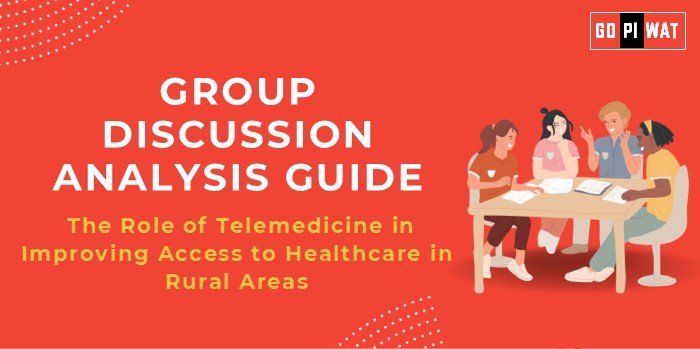📋 Group Discussion Analysis Guide: The Role of Telemedicine in Improving Access to Healthcare in Rural Areas
🌍 Introduction to Telemedicine and Rural Healthcare
📖 Opening Context
Telemedicine has emerged as a revolutionary approach to bridge healthcare disparities, especially in rural areas where medical resources are scarce. Globally, it represents a transformative tool in healthcare delivery, driven by advancements in technology and policy.
📜 Background
The World Health Organization defines telemedicine as the delivery of healthcare services where distance is a critical factor. In India, initiatives like the National Digital Health Mission have propelled telemedicine’s growth, making healthcare more accessible in remote areas.
📊 Quick Facts and Key Statistics
- 🌍 Global Market Value: $60.8 billion in 2023, projected to reach $225 billion by 2030.
- 🏥 Rural Healthcare Gap in India: 74% of doctors cater to urban areas, leaving rural areas underserved.
- 📈 Teleconsultations Growth: eSanjeevani has facilitated over 140 million consultations since launch.
- 📱 Mobile Penetration: 700+ million smartphone users in India, aiding telemedicine expansion.
- 📉 Health Outcomes: Studies show a 30% improvement in chronic disease management using telemedicine.
🤝 Stakeholders and Their Roles
- 🏛️ Government: Develops policies like NDHM and promotes eSanjeevani.
- 🏥 Healthcare Providers: Extend services to underserved regions via telemedicine platforms.
- 💻 Technology Firms: Provide infrastructure, apps, and AI-driven diagnostic tools.
- 👥 Citizens: Access care more conveniently, particularly in remote areas.
- 🌐 NGOs and Global Agencies: Facilitate training and resources for telehealth adoption.
🏆 Achievements and Challenges
✨ Achievements
- 📈 Increased Reach: Over 140 million e-consultations by eSanjeevani in rural India.
- 💵 Cost Efficiency: Reduced travel costs and waiting times for patients.
- 🦠 Pandemic Response: Telemedicine sustained healthcare delivery during COVID-19 lockdowns.
- 🌍 Global Comparisons: Estonia leads in telehealth integration into public healthcare.
⚠️ Challenges
- 📉 Digital Divide: Rural areas face a 33% mobile internet usage gap compared to urban areas.
- ⚖️ Regulatory Hurdles: Lack of uniform telemedicine guidelines globally.
- 💻 Technological Barriers: Limited infrastructure in remote regions of India.
- 📖 Case Study: Despite eSanjeevani’s success, limited digital literacy hinders full adoption in some areas.
💡 Structured Arguments for Discussion
- 👍 Supporting Stance: “Telemedicine has proven to be a game-changer, bringing specialist consultations to the remotest areas, saving lives and time.”
- 👎 Opposing Stance: “Without robust digital infrastructure, telemedicine risks deepening healthcare inequities.”
- ⚖️ Balanced Perspective: “Telemedicine’s potential is immense, but addressing digital literacy and infrastructure gaps is crucial for equitable healthcare access.”
📈 Effective Discussion Approaches
🔑 Opening Approaches
- 📊 “The stark disparity in doctor-to-patient ratios between urban and rural areas underscores telemedicine’s significance.”
- 📖 “With 140 million consultations, eSanjeevani highlights the potential of telemedicine in India.”
🤔 Counter-Argument Handling
- ⚖️ “Acknowledging infrastructure challenges, public-private partnerships can catalyze change.”
- 🌍 “Regulatory hurdles exist, but examples from Estonia show scalable success models.”
🔍 Strategic Analysis of Strengths and Weaknesses
- 🌟 Strengths: Increased reach, cost efficiency, global adoption trends.
- ⚠️ Weaknesses: Infrastructure gaps, digital illiteracy.
- 🚀 Opportunities: AI-driven diagnostics, 5G-enabled teleconsultations.
- ⚡ Threats: Cybersecurity risks, regulatory delays.
📚 Connecting with B-School Applications
- 🌐 Real-World Applications:
- 📋 Potential case studies in operational management and healthcare innovation projects.
- 💬 Sample Interview Questions:
- 🧠 “How can telemedicine align with India’s Universal Health Coverage goals?”
- 📡 “What role does 5G play in expanding telehealth?”
- 💡 Insights for B-School Students:
- 🚀 Opportunities in healthcare management consulting.
- 📈 Growth of tech-driven healthcare startups.


